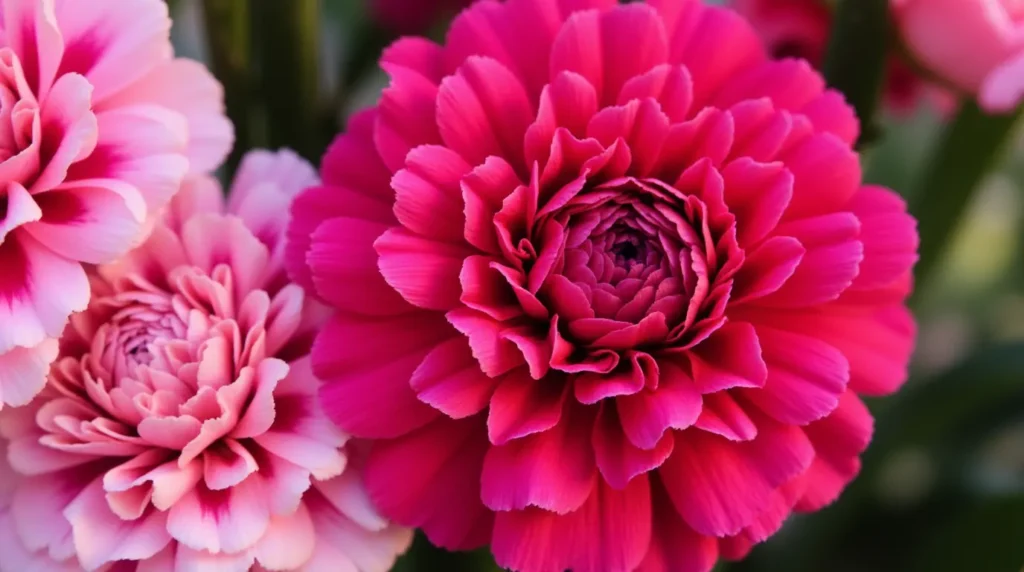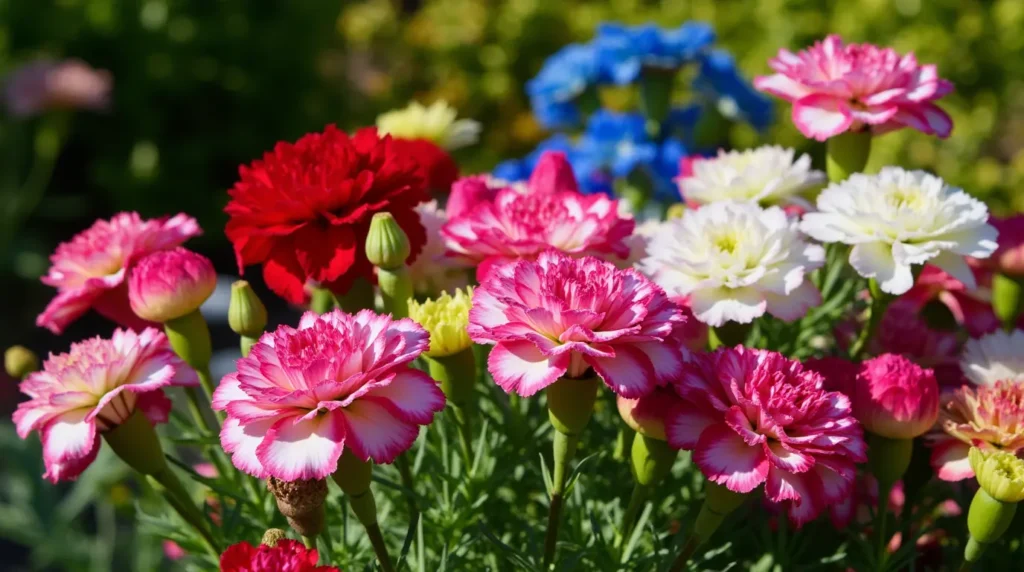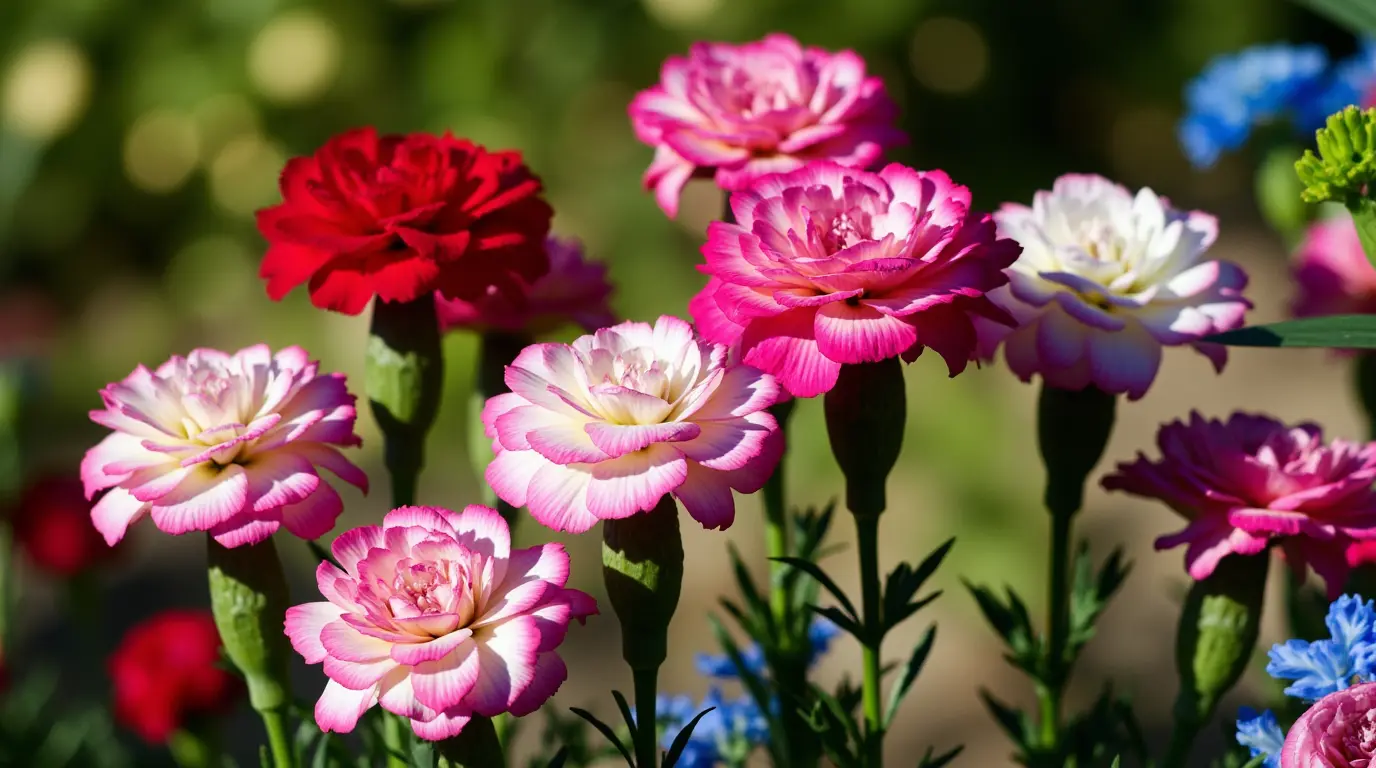Table of Contents
Carnation flowers symbolize love, fascination, and beauty. They come in many colors, like red, white, green, blue, and pink. This guide will help you grow and care for these flowers in your garden.
Learn about the meanings of different carnation colors. Discover the best soil and planting methods. Get ready to create a beautiful carnation garden that will impress everyone.
Key Takeaways
- Carnation flowers come in a wide range of colors, each with its own unique meaning and symbolism.
- Choosing the right carnation variety for your climate and growing conditions is crucial for success.
- Preparing the soil with the proper nutrients and amendments is essential for healthy carnation growth.
- Proper watering, fertilizing, and pruning techniques are key to maintaining a vibrant carnation garden.
- Carnation flowers can be easily propagated from cuttings or seeds, allowing you to expand your collection.
Introduction to Carnation Flowers
Carnations are a beloved flower with a rich history. They have captivated gardeners and flower lovers for centuries. With a wide range of colors, shapes, and sizes, each variety has its own charm.
Carnation Flower Meaning and Symbolism
The carnation flower is linked to love, fascination, and admiration. The pink carnation symbolizes a mother’s love. The white carnation stands for pure love and innocence. The red carnation is a classic sign of deep affection, perfect for Valentine’s Day.
Types of Carnation Flowers
Carnations come in many varieties, each with its own traits. The most common types are:
- Standard carnations: Large, full-bloom flowers with a sturdy stem.
- Spray carnations: Smaller, multi-bloom flowers on a single stem, great for bouquets.
- Mini carnations: Petite, compact flowers ideal for small vases and decorations.
Whether you want to beautify your garden or create a stunning bouquet, carnation flowers are a timeless choice. Discover the different meanings and varieties to find the perfect carnation for you.
Choosing the Right Carnation Variety

Choosing carnation flowers can be a fun adventure. You can pick from the timeless red carnation to the rare blue carnation. With so many carnation colors and sizes, finding the right one can seem hard. But, by thinking about a few key things, you can pick the perfect carnation flower for your garden.
First, think about the size of the blooms. Carnation flowers come in all sizes, from small to big. For a bold look, choose the bigger carnation varieties like the white carnation or pink carnation. For a softer, more romantic feel, go for the smaller ones.
Next, consider how the carnation flower grows. Some are compact and bushy, while others spread out. This will help you decide how to use them in your garden, whether as borders, in pots, or as groundcover.
Lastly, think about the color of the carnation flower. You can choose from the traditional red carnation to the unique blue carnation. Pick colors that match your garden or show off your style.
| Carnation Variety | Bloom Size | Growth Habit | Color |
| Standard Carnation | Large | Upright, bushy | Red, white, pink, yellow |
| Miniature Carnation | Small | Compact, bushy | Red, white, pink, purple |
| Spray Carnation | Medium | Trailing, cascading | White, yellow, bicolor |
| Picotee Carnation | Large | Upright, bushy | Red, pink, white with contrasting edge |
Exploring the different carnation flower varieties can help you find the perfect ones for your garden. Whether you love the classic red carnation or the stunning blue carnation, there’s a wide range of choices. These versatile and beautiful blooms can make your garden come alive.
Preparing the Soil for Carnation Flowers
To grow carnation flowers well, start with the right soil. Carnations need well-drained, nutrient-rich soil. This soil is key for their growth and blooms.
Ideal Soil Conditions for Carnations
Carnations like a neutral to slightly acidic soil. The best pH is between 6.0 and 7.0. This pH helps them absorb nutrients well. Also, the soil must drain well to avoid waterlogging and root rot.
Amending the Soil for Optimal Growth
If your soil isn’t right for growing carnation flowers, you can fix it. Add organic matter like compost or well-rotted manure. This boosts the soil’s nutrients and drainage. Carnations will get the nutrients they need to grow well.
- Mix in 2-4 inches of organic matter to enrich the soil
- Consider adding a slow-release fertilizer to further boost nutrient levels
- Ensure the soil is loose and friable, allowing for proper root development
Preparing the ideal soil for carnations is crucial. It helps your plants grow healthy and bloom beautifully.
Planting Carnation Flowers
Planting carnation flowers right is key for their success and beauty. Whether starting from seed or transplanting, knowing the best time is crucial.
Choosing the Right Planting Time
The best time to plant carnations is in spring or fall. This is when the weather is mild and the soil is moist but not soggy. Carnations do well in USDA hardiness zones 6-9, needing well-draining, fertile soil. Don’t plant in the scorching summer or where it freezes hard, as it can harm the plants.
- Start carnation seeds indoors 8-10 weeks before the last frost.
- Move seedlings outside after frost danger has passed, spacing them 12-15 inches apart.
- For fall planting, get your carnations in the ground 4-6 weeks before the first frost.
Make sure the soil is ready, with a pH of 6.0 to 7.0. Add compost or well-rotted manure to improve it. Plant carnations 1-2 inches deep and water well to help roots grow strong.
By following these tips for when to plant carnations, your flowers will thrive. You’ll enjoy a rich harvest of these lovely, fragrant blooms.
Caring for Carnation Flowers

Proper care is key for your carnation flowers to stay healthy and bloom brightly. This includes the right watering and fertilizing schedule. We’ll guide you on how to keep your carnations looking great all season.
Watering Carnation Flowers
Carnations need regular, moderate watering to do well. Water them about 1 inch per week. Change this based on your environment. Make sure the soil isn’t too dry or too wet, as both can harm your carnations.
Fertilizing Carnation Flowers
Feeding your carnation flowers the right nutrients is vital. Use a balanced, water-soluble fertilizer every 2-4 weeks during growing season. Follow the instructions carefully. Or, use a slow-release granular fertilizer at the start of the season.
- Choose a fertilizer made for carnation flowers or other blooming plants
- Don’t over-fertilize, as it can make foliage grow too much and reduce blooms
- Adjust how much fertilizer you use based on your carnations and growing conditions
By giving your carnation flowers the right water and nutrients, they’ll thrive. They’ll also put on a beautiful show of color all season.
Pruning and Deadheading Carnation Flowers
Keeping your carnation flowers healthy and looking good needs regular pruning and deadheading. These steps help your carnations bloom continuously. They also keep your garden looking neat and beautiful.
Pruning carnations means cutting off old or damaged flowers. This helps the plant grow new, colorful blooms. Use sharp scissors or pruners to cut the stem just above a healthy leaf or bud.
- Deadheading means removing old or wilted carnation flowers. It stops the plant from spending energy on seeds. Instead, it focuses on growing more flowers.
- To deadhead, gently pinch or snip the old flower head. Be careful not to hurt the leaves around it.
Pruning and deadheading your carnations can make them bloom longer. These simple steps help keep your carnations looking great. Enjoy a beautiful and lasting carnation display in your garden.
Overwintering Carnation Flowers
As winter gets closer, it’s key to keep your carnation plants alive. This way, they can bloom again in the spring. Here are some great ways to keep your carnations thriving:
Mulching for Protection
Spread a 2-4 inch layer of organic mulch, like wood chips or leaves, around your carnations. It keeps the roots warm and safe from frost.
Guarding Against Frost
- Use a frost blanket or row cover to protect your carnations from cold.
- If your carnations are in pots, move them to a warm place like a greenhouse or cold frame.
Storing Potted Carnations Indoors
For carnations in pots, bring them inside a cool, bright room or basement in winter. Water them a little, just to keep the soil moist.
By using these easy overwintering tips, your carnation flowers will come back strong in the spring. They’ll brighten up your garden or add beauty to your home.
Carnation Flower Propagation
Want to grow more carnations? Learn how to make new plants from cuttings or seeds. We’ll show you how to do it step by step, with tips for success.
Propagating Carnations from Cuttings
Want to grow how to grow carnation flowers that are just like the original? Cutting propagation is a great way. Here’s how to do it:
- Take a 4-6 inch cutting from a healthy carnation plant, making sure to include at least one node.
- Remove the lower leaves and dip the cut end in a rooting hormone powder to encourage root growth.
- Plant the cutting in well-draining potting mix and keep the soil consistently moist but not waterlogged.
- Place the cutting in a warm, bright location out of direct sunlight and wait 4-6 weeks for roots to develop.
- Once rooted, transplant the new carnation plant into a larger container or into your garden.
Growing Carnations from Seeds
Growing carnations from seed is another option, but it takes longer. Here’s how to grow them from seeds:
- Start carnation seeds indoors 8-10 weeks before the last expected frost date in your area.
- Sow the seeds in a seed starting tray filled with a well-draining seed starting mix.
- Cover the seeds lightly with soil and keep the tray in a warm, sunny location until the seeds germinate.
- Once the seedlings have their first set of true leaves, transplant them into individual containers.
- Gradually introduce the young plants to more sunlight and cooler temperatures to harden them off.
- Transplant the propagating carnations into your garden after the last frost, spacing them about 12 inches apart.
Whether you choose to how to grow carnation flowers propagate from cuttings or grow from seed, carnations are rewarding plants. They will give you plenty of vibrant blooms to enjoy for years.
Troubleshooting Common Carnation Problems
Even the most experienced carnation enthusiasts may face challenges. Knowing the common pests and diseases is key to keeping your plants healthy.
Pests and Diseases Affecting Carnations
Carnations can face many pests and diseases. Here are some common ones:
- Rust: This fungal disease causes orange, powdery spots on leaves and stems. It leads to stunted growth and fewer flowers.
- Root Rot: Caused by Fusarium or Pythium fungi, it makes roots decay. This causes wilting, yellowing, and can kill the plant.
- Aphids: These small, sap-sucking insects can infest carnation plants. They cause distorted growth and can spread viral diseases.
- Thrips: Tiny, slender insects that feed on leaves and flowers. They cause discoloration, distortion, and lower bloom quality.
- Botrytis Blight: A fungal disease that causes gray, fuzzy growth on leaves, stems, and flowers. It leads to petal drop and plant decline.
Being vigilant and proactive is crucial. Regular checks, proper care, and timely treatments can help your carnations stay healthy.
| Pest or Disease | Symptoms | Prevention and Treatment |
| Rust | Orange, powdery spots on leaves and stems | Maintain good air circulation, remove affected foliage, and apply fungicides as needed. |
| Root Rot | Wilting, yellowing, and plant decline | Improve soil drainage, avoid overwatering, and use disease-resistant cultivars. |
| Aphids | Distorted growth and potential virus transmission | Encourage natural predators, use insecticidal soap or neem oil, and remove affected foliage. |
Harvesting and Enjoying Carnation Flowers
Carnations are a joy to grow and harvest. They add beauty to bouquets. Learning how to cut and care for them makes a big difference.
Cut Carnation Flowers for Bouquets
For bouquets, cut carnations in the morning. Use sharp scissors or pruning shears. Cut 4-6 inches from the base, leaving some leaves for regrowth.
Choose blooms that are fully open and firm. Skip wilted or damaged flowers. Put the stems in water to keep them fresh.
Adding floral preservative to the water helps. It keeps your carnations looking great for weeks.
| Tip | Benefit |
| Cut stems at an angle | Increases surface area for water absorption |
| Use clean, sharp tools | Prevents damage and promotes healing |
| Add floral preservative to water | Extends the lifespan of cut carnations |
By following these steps, you can enjoy your homegrown carnations. They add color and fragrance to your space. Share the beauty of harvesting carnations with others.
Conclusion
You now know how to grow and care for carnation flowers in your garden. These flowers come in many colors, like red and blue. They add beauty, smell, and meaning to your garden.
Carnation flowers are versatile and charming. They can brighten your garden for many seasons. Try different carnation flower varieties, like pink or white, to show off your style.
With the right soil and care, your carnation flowers will thrive. Enjoy watching them grow and take pride in your gardening skills.
FAQ
What is the meaning and symbolism of carnation flowers?
Carnations have deep meanings. The red ones show love and admiration. Pink ones mean thankfulness and a mother’s love. White ones symbolize purity and innocence. Yellow ones bring cheer and new starts.
They also come in green and blue, showing growth and uniqueness.
What are the different types of carnation flowers?
There are many types of carnations. Standard ones have big blooms. Spray carnations have many small blooms on one stem. Mini carnations are small and perfect for adding a touch to bouquets.
How do I choose the right carnation variety for my garden?
Pick carnations based on size, color, and growth. Classic colors like red, pink, and white are popular. But, you can also find blue, green, and bicolor ones.
Think about your garden’s style and climate. Choose varieties that fit well.
What are the ideal soil conditions for growing carnation flowers?
Carnations love well-drained, rich soil that’s slightly acidic. Aim for a pH between 6.0 and 6.5. Adding compost can help your soil be perfect for carnations.
When is the best time to plant carnation flowers?
Plant carnations in the spring or fall, depending on your climate. In cooler areas, plant in spring after the last frost. In warmer places, fall planting is best.
How do I care for my carnation flowers?
To keep carnations healthy, water them consistently and fertilize every 4-6 weeks. Deadheading and pruning help them bloom more and look neat.
How do I overwinter my carnation plants?
Protect carnations from winter cold. Mulch around the base and cover with burlap or frost blankets. For potted ones, bring them inside or store in a cool place until spring.
How can I propagate more carnation plants?
You can grow more carnations from cuttings or seeds. Cuttings need a potting mix to root. Seeds should be started indoors and then moved outside when strong.
Propagating is a good way to share these lovely flowers.
What are some common pests and diseases that affect carnation flowers?
Carnations face issues like rust, root rot, and aphids. Rust spots leaves and stems. Root rot causes wilting. Aphids suck sap.
Keep your growing conditions right and deal with problems fast to avoid these issues.
How do I harvest and enjoy my carnation flowers?
Cut carnations in the morning for bouquets. Cut stems at an angle and leave 12-18 inches. Place in water right away and change it daily.
With care, your bouquets can last up to 2 weeks, filling your home with fragrance.

